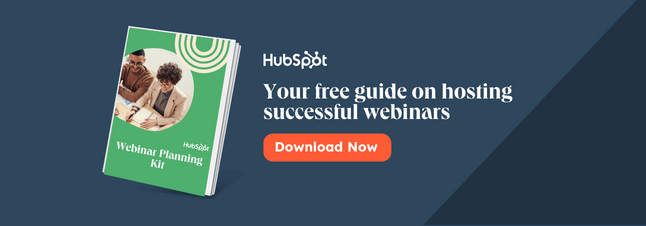According to research from InsideSales.com, 73% of marketing and sales leaders say webinars are one of the best ways to generate high-quality leads. With this in mind, you don’t want to let these valuable leads languish in post-webinar purgatory. Here are nine simple ways to convert more webinar leads into sales.
How to Host Webinars That Convert
1. Pick a topic that's relevant to your industry.
Is there a problem point, trend, or other topic that people in your industry are particularly buzzing about or reaching out to you for guidance on? If so, this could be a great topic that drives in webinar signups, attendees, and possibly conversions.
If your business offers solutions or services related to the topic or pain point discussed in the webinar, that's even better. This will give you a platform where you can inform the audience about the topic, demonstrate your expertise in it, and then promote the product or service that corresponds in it. People who feel that your brand is knowledgeable about a certain pain point might trust that you've created a great solution that can help them/
2. Consider letting a thought leader or credible customer host.
By having a thought leader host, you can also demonstrate knowledge, expertise, and credibility in your industry. If people follow the thought leader, promoting the webinar and noting that this person is a host might also drive sign ups and attendees.
If you have a customer with a large amount of credibility in your industry who can talk about strategies they've used related to a certain topic while possibly intertwining mentions of your product in the webinar, this is a definite bonus. This way, listeners are getting the knowledge and advice that they're craving, but they're also getting a trustworthy endorsement of your product directly from someone who's used it.
3. Make the webinar interactive.
As you and your host plan the webinar, come up with ways to make it interactive for the customer. Interactivity adds to the experience and can also be valuable to the listener.
For example, if your webinar system allows listeners to submit comments, consider including points in your webinar where you ask the listeners to reply with their strategies. Then read and discuss the best ones. You could also allow time at the end where webinar listeners could ask questions and the host could answer two or three of the best ones.
If your webinar system doesn't allow questions, you could include this as a piece of the promotion. For example, if you post a link to the webinar signup page on your social channels, ask those interested to comment on your promotional post with a question for the host. Then similarly ask the best ones and give a shout out to the person who asked the question.
Another way you can get more interactive is by polling the audience, if that feature is available on your webinar system. This, again, makes the experience more interactive and entertaining for your audiences. But, additionally, they can view and learn from the results of other peers watching the webinar.
All in all, an interactive experience will create value and potentially please the prospect into signing up for more webinars or even investing in your product.
9 Easy Ways to Convert Webinar Leads into Sales
1. Poll your audience to see who’s ready to buy.
At GoToWebinar, we always use multiple polls during our webinars. They grab attendees’ attention and prompt them to take part in the action. Poll responses provide handy insights you can use to segment your audience by need, interest level, industry, and more, too.
Polling your attendees during the webinar will also help you find out if they’re interested in learning more about your company or talking to a sales representative. Bear in mind, this technique is not suited for top-of-the-funnel webinars that are unrelated to your product. You don’t want to hit attendees with a “buy now” message when they are still in the discovery phase.
Additionally, polling your attendees during the webinar -- rather than polling them in a post-webinar email -- will yield a much higher response rate. If attendees respond in the affirmative, pass them to your sales team for follow-up.
If you get a lot of positive poll responses, take time at the end of your webinar to demo your product or show your attendees how they can purchase it. Those who aren’t interested can hop off and those who are interested will appreciate the extra info.
2. Send a post-webinar survey.
Sending attendees a quick survey right after the webinar is a great way to see if your content resonated with them, capture additional attendee insights, and gauge attendee interest in your product.
If you didn’t ask them these questions during the webinar, ask them who’s ready to take the next step in a post-webinar survey. You can also use survey responses to segment your webinar attendees and tailor your follow up marketing messages.
3. Involve your sales team in the webinar.
Collaboration between marketing and sales sounds like a no-brainer, but it’s easy to overlook. To involve the sales team in your webinars, make sure they know what webinars are on the calendar and what topic they’ll cover. This will help the sales team prepare more thorough follow-up communication with webinar leads and keep your marketing efforts aligned with your company’s sales goals.
At GoToWebinar, we recommend going a step further and having sales reps join the webinar. They can even help run the webinar, fielding and answering attendee questions.
By taking part in the webinar, sales reps will get familiar with the topic. They’ll also notice that most attendees are engaged, which will make them all the more motivated to follow-up. This sets the groundwork to seamlessly pass the top webinar leads from marketing to sales.
4. Follow up within 24 hours.
While it’s still fresh in their minds, send out your first email follow-up to webinar attendees and no-shows within 24 hours of the webinar. Your audience expects to receive the webinar recording and presentation slides, regardless if they showed up or not.
Prospects also love when companies include a link to a follow-up blog post that summarizes the webinar content and answers some of the top attendee questions. Sure, it takes extra planning and a quick turnaround to do this, but you’re fostering a relationship with these prospects -- this type of targeted content is key to converting your audience down the line.
5. Identify hot, warm, and cold leads.
You don’t have to use all three lead categories, but at the very least, divide your leads into hot leads that are ready for sales and ones that need to be nurtured.
We’ve already discussed two ways to identify hot leads -- using a poll or survey -- but you also have access to a lot of other data that can help you pinpoint where leads are in their buyer’s journey.
Look at data like:
- Registration responses: go beyond only asking for name and email on your webinar registration form. Ask more probing questions that will help segment and personalize your marketing.
- Attendee interest rating: if you’re using a solution like GoToWebinar or Zoom Video Webinar, you will have webinar reports that display your attendees’ engagement level over the course of the webinar.
- Previous marketing engagement: this includes web behavior, content downloads, and prior webinar activity.
6. Send personalized follow-ups to hot leads.
Passing on your sales-ready webinar leads with specific instructions for how to follow up will increase the odds your sales team will close these prospects. You could also go a step further and provide your sales reps with a customizable email template. The easier you make their job, the more likely they’ll hit it out of the park.
This follow-up messaging should relate to the webinar content, provide value, and offer help. It’s also effective to personalize these messages as much as possible based on what you know about each prospect.
7. Nurture warm and cold leads.
Even if some of your webinar leads aren’t ready to buy today, you don’t want to waste the opportunity of closing them when they do become ready to buy. Putting warm and cold webinar leads into your existing nurture tracks based on your usual segmentation will boost the chances that they’ll contact your company when they’re thinking about purchasing your solution.
Alternatively, you can create a webinar-specific nurturing track for these leads, if you have the resources. As you develop your nurturing content, think about what stage of the buying cycle the various segments of your attendees are in and identify other key content assets you can offer in your nurturing stream that build on your webinar content.
The length of the nurturing stream will depend on your sales cycle, but four to six weeks is a good place to start.
8. Retarget your webinar leads.
Creating retargeting campaigns for your webinar leads will keep your brand top of mind. Again, you can segment these audiences based off their responses, interest level, and previous marketing engagement, but the point is to keep your leads warm and move them through each stage of the journey.
Remember, retargeting ads should complement your other marketing tactics. You don’t want to email webinar leads with a discount offer and retarget them with an awareness ad at the same time.
9. Always empower leads to take action.
It’s always better to make it easy for your prospects to take the next step in their buyer's journey. Even if your leads aren’t quite ready to become customers, give them the ability to keep learning with additional resources and ways to engage. Whether it’s during the webinar or in your follow-up emails, including a clear call to action and highlighting its benefit will entice your audience to take the next step with your business.
Webinar leads are some of your best leads.
A recent GoToWebinar study on content engagement revealed that people are willing to spend more time with a webinar than any other type of content. These are some of your most engaged leads, so make sure you have a plan to convert them. If you’re not ready for all these tactics, just start with a couple and you could see your webinar conversions gradually take off.
Editor's Note: This blog post was originally published in November 2017 but was updated in November 2019 for comprehensiveness.
Webinars











![How to Write a Webinar Script [+ Template]](https://53.fs1.hubspotusercontent-na1.net/hubfs/53/181_Write-a-Webinar-Script.png)